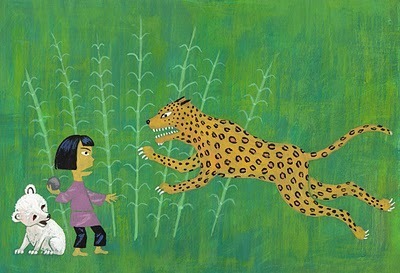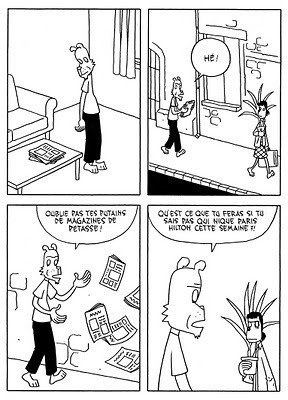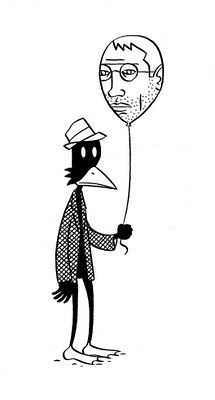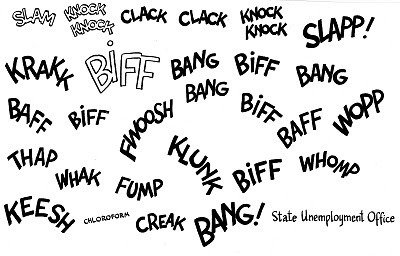Jason's Blog, page 188
January 22, 2011
That Man From Rio
I was going to see Zazie Dans Le Metro, the fourth film in the Louis Malle collection, but it's quite different from the other films, more experimental with the actors acting in a non-realistic style and some images speeded up a la Benny Hill, and it finally got a bit tiresome, so I gave up after 20 minutes and rather put in L'Homme de Rio or That Man From Rio. In a previous post I mentioned Jean-Paul Belmondo and a barfight and this is the film I had in mind.
Belmondo is a soldier on leave who arrives in Paris just in time to see his girlfriend being kidnapped. He rushes after her and they both end up in Rio de Janeiro, searching for an Inca treasure. The girlfriend is played by Françoise Dorleac, the sister of Catherine Deneuve, who tragically died just a few years after this film. Also starring Jean Servais, directed by Philippe De Broca.
This is one of those films I saw on tv as a kid and still have some nostalgic feelings for. An interesting thing about it is the influence from Tintin. There are several visual cues taken directly from the Hergé albums. Dorleac is very cute and Belmondo creates his screen persona for a lot of his work in the 70s. The direction is not much to brag about. Visually the film actually is a bit ugly, filmed in a let's get it done already-style, never bothering with things like building tension. It's far from the mastery of someone like Hitchcock. Of course, when you're twelve you don't notice any of that, you just see the story. It's still a fun film, but it's possible that it's better to see it at that age than as an adult.
Belmondo is a soldier on leave who arrives in Paris just in time to see his girlfriend being kidnapped. He rushes after her and they both end up in Rio de Janeiro, searching for an Inca treasure. The girlfriend is played by Françoise Dorleac, the sister of Catherine Deneuve, who tragically died just a few years after this film. Also starring Jean Servais, directed by Philippe De Broca.
This is one of those films I saw on tv as a kid and still have some nostalgic feelings for. An interesting thing about it is the influence from Tintin. There are several visual cues taken directly from the Hergé albums. Dorleac is very cute and Belmondo creates his screen persona for a lot of his work in the 70s. The direction is not much to brag about. Visually the film actually is a bit ugly, filmed in a let's get it done already-style, never bothering with things like building tension. It's far from the mastery of someone like Hitchcock. Of course, when you're twelve you don't notice any of that, you just see the story. It's still a fun film, but it's possible that it's better to see it at that age than as an adult.
Published on January 22, 2011 01:25
Joni Mitchell
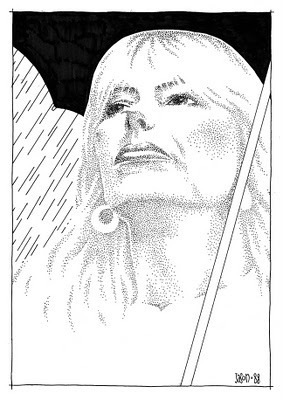
Well, at least it's supposed to look like her. Drawing for a music magazine, late 80s, for a review of her album Chalk Mark in a Rain Storm.
Published on January 22, 2011 00:33
January 21, 2011
Les Amants
It's the third film in the Louis Malle box-set. Jeanne Moreau is living in a loveless marriage with a wealthy newspaperowner.
It's a bit hard to care about people who have servants, no matter how unhappy they are. When Moreau starts having an affair with a poloplayer I was just about to stop the film and move on to the next. But then, on the way back to Paris her car breaks down and she meets a younger student who drives her the rest of the way. They have a conversation, he makes a joke that makes her laugh, and she comes to life for the first time in the film. The rest is pure movie magic, Moreau's face is poetry on the screen. It's hard to understand that this film, from 58, was once considered shocking, even obscene. In a Hollywood film there would have been some form of punishment, death probably, but in this film they drive happily off into the future. There's still some ambiguity, though, if the happiness can last.
It reminded me a bit of the ending of The Graduate, a very romantic, triumphant ending, with Dustin Hoffmann breaking into the church, snatching his girlfriend right in the middle of the wedding and then escaping on a bus, but how can things ever go up from there? They can only go down, and in my mind at least, for that film, there's an epilogue 20 years later where she curses him for doing it, she could have been happy, and look at them now.
It's a bit hard to care about people who have servants, no matter how unhappy they are. When Moreau starts having an affair with a poloplayer I was just about to stop the film and move on to the next. But then, on the way back to Paris her car breaks down and she meets a younger student who drives her the rest of the way. They have a conversation, he makes a joke that makes her laugh, and she comes to life for the first time in the film. The rest is pure movie magic, Moreau's face is poetry on the screen. It's hard to understand that this film, from 58, was once considered shocking, even obscene. In a Hollywood film there would have been some form of punishment, death probably, but in this film they drive happily off into the future. There's still some ambiguity, though, if the happiness can last.
It reminded me a bit of the ending of The Graduate, a very romantic, triumphant ending, with Dustin Hoffmann breaking into the church, snatching his girlfriend right in the middle of the wedding and then escaping on a bus, but how can things ever go up from there? They can only go down, and in my mind at least, for that film, there's an epilogue 20 years later where she curses him for doing it, she could have been happy, and look at them now.
Published on January 21, 2011 00:57
And another
Published on January 21, 2011 00:39
January 20, 2011
Another illustration...
Published on January 20, 2011 00:12
January 19, 2011
Finished page
Published on January 19, 2011 07:58
Thumbnail sketches...
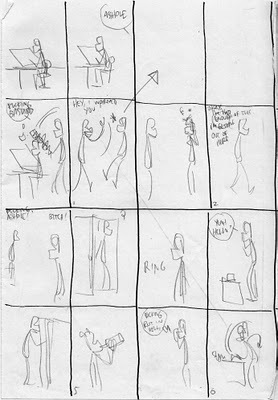
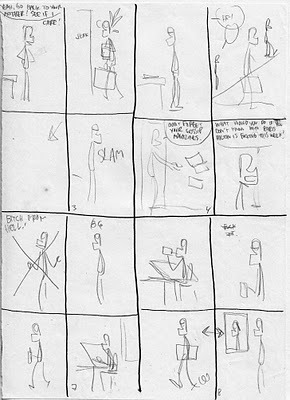
... from one of the stories in Athos in America. Page 1 and 2 is at the upper half of the first image, page 3 and 4 at the upper half of the second image, you then need to go to the lower half of the first image for page 5 and 6 and so on. Sometimes I draw directly on the original, sometimes I first make these small sketches to see how the story should be told. The text is not final, I'll work on that as I'm drawing.
Published on January 19, 2011 01:07
January 18, 2011
A selfportrait...
Published on January 18, 2011 07:02
Sound effects...
Published on January 18, 2011 00:28
January 17, 2011
Some books I've read 2
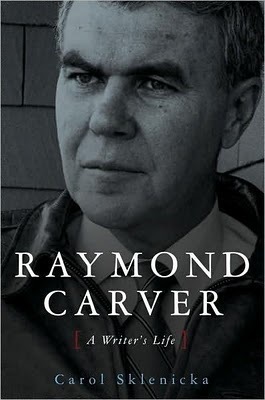
Carol Sklenicka's biography of Raymond Carver
It's an interesting read, especially about the years lost to alcoholism (but which, of course, gave him a lot of material for his short stories) and his relationship with his editor, Gordon Lish, who took out half the text in What We Talk About When We Talk About Love, and then refused to discuss changing it back.
Beginners by Raymond Carver
This is the original, unedited text. It's good to have, to be able to compare the two versions. It's far from minimalistic, a term that was often given him. I should probably re-read WWTAWWTAL before saying anything, but I think A Small, Good Thing, one of his most famous stories, is wastly better in the longer, original version. The Lish version is really butchered. But, possibly, Tell The Women We're Going and One More Thing, I might actually prefer the Lish versions. He gave those two stories final punchlines, and for Tell The Women it's maybe better to imagine what really happened than being told.
Sunset Park by Paul Auster
After some disappointing books I think this book and the previous one, Invisible, have been much better.
Currently reading: I Was Looking for a Street by Charles Willeford
And on my bedside table, waiting to be read: Jack Kerouac, Selected Letters 1940 - 1956 and Selected Letters 1957 - 1969.
Published on January 17, 2011 04:39
Jason's Blog
- Jason's profile
- 703 followers
Jason isn't a Goodreads Author
(yet),
but they
do have a blog,
so here are some recent posts imported from
their feed.



